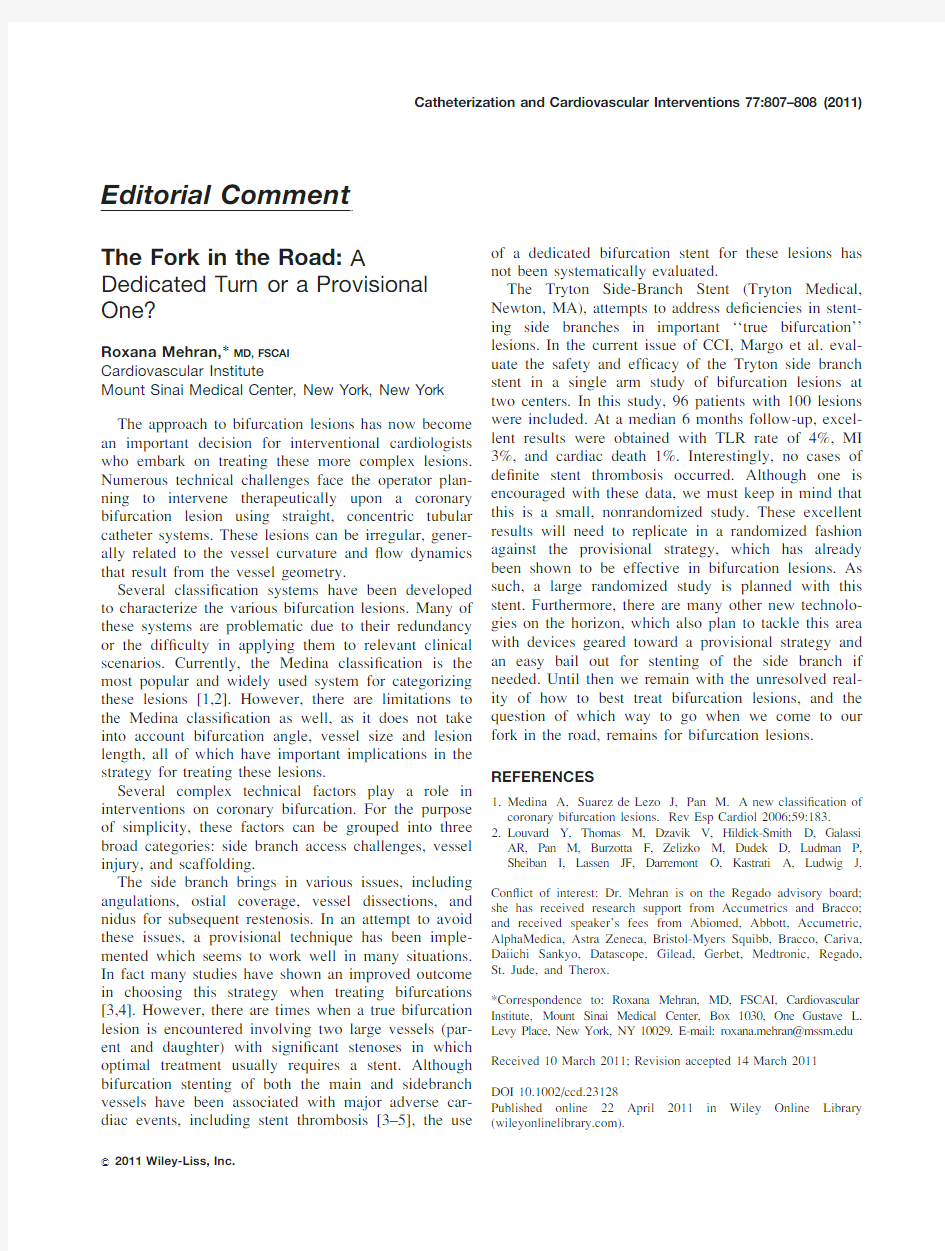Tryton_MehranEditorial_CCI_Magro2011


Editorial Comment
The Fork in the Road:A Dedicated Turn or a Provisional One?
Roxana Mehran,*MD,FSCAI
Cardiovascular Institute
Mount Sinai Medical Center,New York,New York The approach to bifurcation lesions has now become an important decision for interventional cardiologists who embark on treating these more complex lesions. Numerous technical challenges face the operator plan-ning to intervene therapeutically upon a coronary bifurcation lesion using straight,concentric tubular catheter systems.These lesions can be irregular,gener-ally related to the vessel curvature and?ow dynamics that result from the vessel geometry.
Several classi?cation systems have been developed to characterize the various bifurcation lesions.Many of these systems are problematic due to their redundancy or the dif?culty in applying them to relevant clinical scenarios.Currently,the Medina classi?cation is the most popular and widely used system for categorizing these lesions[1,2].However,there are limitations to the Medina classi?cation as well,as it does not take into account bifurcation angle,vessel size and lesion length,all of which have important implications in the strategy for treating these lesions.
Several complex technical factors play a role in interventions on coronary bifurcation.For the purpose of simplicity,these factors can be grouped into three broad categories:side branch access challenges,vessel injury,and scaffolding.
The side branch brings in various issues,including angulations,ostial coverage,vessel dissections,and nidus for subsequent restenosis.In an attempt to avoid these issues,a provisional technique has been imple-mented which seems to work well in many situations. In fact many studies have shown an improved outcome in choosing this strategy when treating bifurcations [3,4].However,there are times when a true bifurcation lesion is encountered involving two large vessels(par-ent and daughter)with signi?cant stenoses in which optimal treatment usually requires a stent.Although bifurcation stenting of both the main and sidebranch vessels have been associated with major adverse car-diac events,including stent thrombosis[3–5],the use of a dedicated bifurcation stent for these lesions has not been systematically evaluated.
The Tryton Side-Branch Stent(Tryton Medical, Newton,MA),attempts to address de?ciencies in stent-ing side branches in important‘‘true bifurcation’’lesions.In the current issue of CCI,Margo et al.eval-uate the safety and ef?cacy of the Tryton side branch stent in a single arm study of bifurcation lesions at two centers.In this study,96patients with100lesions were included.At a median6months follow-up,excel-lent results were obtained with TLR rate of4%,MI 3%,and cardiac death1%.Interestingly,no cases of de?nite stent thrombosis occurred.Although one is encouraged with these data,we must keep in mind that this is a small,nonrandomized study.These excellent results will need to replicate in a randomized fashion against the provisional strategy,which has already been shown to be effective in bifurcation lesions.As such,a large randomized study is planned with this stent.Furthermore,there are many other new technolo-gies on the horizon,which also plan to tackle this area with devices geared toward a provisional strategy and an easy bail out for stenting of the side branch if needed.Until then we remain with the unresolved real-ity of how to best treat bifurcation lesions,and the question of which way to go when we come to our fork in the road,remains for bifurcation lesions. REFERENCES
1.Medina A,Suarez de Lezo J,Pan M.A new classi?cation of
coronary bifurcation lesions.Rev Esp Cardiol2006;59:183.
2.Louvard Y,Thomas M,Dzavik V,Hildick-Smith D,Galassi
AR,Pan M,Burzotta F,Zelizko M,Dudek D,Ludman P, Sheiban I,Lassen JF,Darremont O,Kastrati A,Ludwig J, Con?ict of interest:Dr.Mehran is on the Regado advisory board; she has received research support from Accumetrics and Bracco; and received speaker’s fees from Abiomed,Abbott,Accumetric, AlphaMedica,Astra Zeneca,Bristol-Myers Squibb,Bracco,Cariva, Daiichi Sankyo,Datascope,Gilead,Gerbet,Medtronic,Regado, St.Jude,and Therox.
*Correspondence to:Roxana Mehran,MD,FSCAI,Cardiovascular Institute,Mount Sinai Medical Center,Box1030,One Gustave L. Levy Place,New York,NY10029.E-mail:roxana.mehran@https://www.wendangku.net/doc/5017871090.html,
Received10March2011;Revision accepted14March2011
DOI10.1002/ccd.23128
Published online22April2011in Wiley Online Library (https://www.wendangku.net/doc/5017871090.html,).
'2011Wiley-Liss,Inc.
Catheterization and Cardiovascular Interventions77:807–808(2011)
Iakovou I,Brunel P,Lansky A,Meerkin D,Legrand V, Medina A,Lefevre T.Classi?cation of coronary artery bifurca-tion lesions and treatments:Time for a consensus!Catheter Cardio-vasc Interv2008;71:175–183.
3.Hildick-Smith D,de Belder AJ,Cooter N,Curzen NP,
Clayton TC,Oldroyd KG,Bennett L,Holmberg S,Cotton JM,Glennon PE,Thomas MR,Maccarthy PA,Baumbach A,Mulvihill NT,Henderson RA,Redwood SR,Starkey IR,Stables RH.Randomized trial of simple versus complex drug-eluting stenting for bifurcation lesions:The british bifurca-tion coronary study:Old,new,and evolving strategies.Circula-tion2010;121:1235–1243.4.Routledge HC,Lefevre T,Colombo A,Oldroyd KG,
Hamm CW,Guagliumi G,von Scheidt W,Guetta V, Ruzyllo W,Wittebols K,Goedhart DM,Serruys PW.
Three-year clinical outcome of percutaneous treatment of bifurcation lesions in multivessel coronary artery disease with the sirolimus-eluting stent:Insights from the arterial revascu-larisation therapies study,part ii(arts ii).EuroIntervention 2009;5:190–196.
5.Colombo A,Moses JW,Morice MC,Ludwig J,Holmes DR,
Jr.,Spanos V,Louvard Y,Desmedt B,Di Mario C,Leon MB.Randomized study to evaluate sirolimus-eluting stents implanted at coronary bifurcation lesions.Circulation2004;109:1244–1249.
Catheterization and Cardiovascular Interventions DOI10.1002/ccd.
Published on behalf of The Society for Cardiovascular Angiography and Interventions(SCAI). 808Mehran
